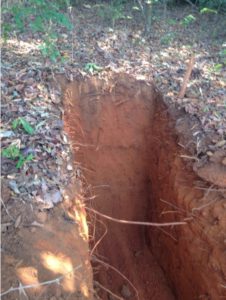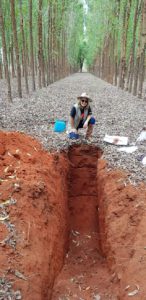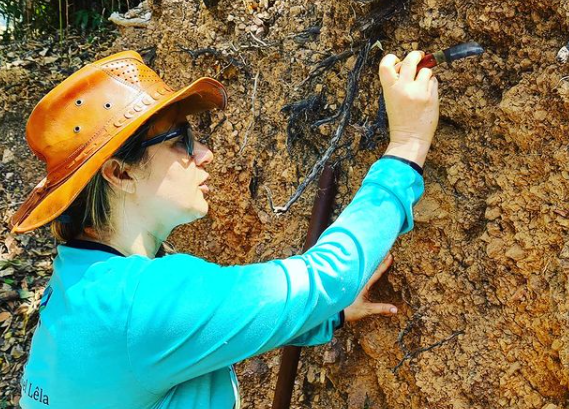“Soil education actions have been applied from elementary education to college level and reach the field as a support to the farmer”
Adriana Aparecida Ribon is Professor at State University of Goiás, where she was the director of the Palmeiras de Goiás campus, and Dean of Extension, Culture and Student Affairs. Since 2011 she coordinates the Soil Education Extension Project for All.
Ribon is an Agronomist and Post-Doctorate in Soil Science from UNESP, Ph.D. in Agronomy (Soil Science) from UEL, and Master from UNESP in Soil Science.
Concern about soil health and food production worldwide has intensified. Land may be our greatest ally, but over the next 25 years land degradation could reduce global food productivity by up to 12%, leading to a 30% increase in world food prices.
More studies are being directed towards an adequate management of soils in a rational way, aiming at crop yields with less degradation.
Brazil has a wide diversity of soils represented by 13 soil orders. Most are represented by the Order of Latosols, which have low natural fertility resulting from highly weatherable minerals. Intense cultivation and unplanned human activities can promote degradation in this environment.
For an adequate and directed planning, aiming at crop yield without soil degradation, it is necessary to have extensive knowledge about soil characteristics. Pedological classification is essential: it helps in choosing the best way to manage its chemical and physical fertility, promoting better targeting of liming and fertilization practices, besides the management of physical attributes, indicators of the state and degree of compression.
However, this soils classification is not used much by farmers.
Pedological Indicators: Beyond The Topsoil
Knowing pedological indicators for each soil class allows a more adequate management system, minimizing the impacts of land use and occupation.
An example of management without detailed knowledge of pedological attributes concerns the management of soil fertility: indications of fertilizer, lime and gypsum doses based only on soil texture (clay contents), without knowing the type of mineralogy present in the clay fraction of soils. Latosols, for example, due to advanced weathering, their clay mineral type can present low water and nutrient retention, making the reserve of nutrients insufficient for the plants, even when they fall into textural classes between clayey and very clayey.

Profile of a Red Yellow Latosol under native forest (Palmeiras de Goiás, Goiás State)
Another important aspect is the high adsorption capacity of phosphorus (phosphate anions) by Latosols, which have a greater amount of iron and aluminum oxides present in the clay fraction, making it difficult to manage phosphate fertilization.
Pedological indicators (morphological, physical, chemical and mineralogical attributes) must be characterized beyond the superficial layers of the soil.
Attributes identified in the soil profiles for “beyond the topsoil” are relevant to asses potential nutrient availability, salinity, nutrient losses through volatilization and greenhouse gas emissions.
Considering soil management as clusters, the relationships between its attributes, physical properties, indicative of compaction and densification, must also be evaluated in the subsurface. Dense or compacted layers affect root growth and, consequently, the availability and absorption of water, aeration and absorption of nutrients by plant roots.
Consequently, the classification and pedological characterization of the soils ensures proper management and help in the evaluation potentials and limitations for agricultural use.
Practical Applications of Pedology: Academic Context
Since 2013, the State University of Goiás (UEG) has carried out research with the objective of relating soil classification to fertility, generating a targeted management for each agricultural area.
The data are replicated with soybean farmers in the region aiming at soil recovery, cost reduction and increased productivity. There are few farmers who seek research results relating to the classification of soils and their attributes with chemical and physical fertility of the soil to obtain a better response from fertilization, and, therefore, higher yield.
Hence, a more targeted fertilization recommendation is made. We can make the farmer decrease their outlay, seeking a better cost-benefit.
Pedology Employment case
Agronomist Regis Rates de Melo, farmer in Palmeiras de Goiás, Goias State, decided to practice this theory on his property. Regis reveals that for at least 10 years there was no management with crop rotation in the soybean area under no-tillage system, resulting in soil compaction and productivity stagnant at 48 bags per hectare.
Therefore, a description of the soil profile was made in a trench opened in a representative way in the middle of the cultivation and soil samples were taken for morphological, chemical, physical and mineralogical analysis up to 1.5 m in depth. The soil was classified according to the Brazilian System of Soil Classification as Red Yellow Latosol, an order with low natural fertility. “It is important to know the soil class, as it has different properties. This seeks to manage fertility in a differentiated way”.
After this initial analysis, the recommendation was focused on increasing soil organic matter. The idea was to replace the organic matter in the form of an organic-mineral fertilizer to improve the retention of nutrients in this soil. The results reflected in plant’s vigor: “It is more beautiful, robust, resistant and less susceptible to changes in climate and pests”, says Melo. It was a long-lasting experiment with satisfactory reflections in the coming seasons.
The research associates soil mineralogy attributes to help define fertilization. This is an extremely significant advance. Currently, we know that several properties do not maximize fertilizer use. Farmers needs to be concerned about making a good soil analysis and verifying what its deficiencies are, but also concerned about attributes that go far beyond the topsoil. Only then will it be able to overcome this deficiency with the use of liming and fertilization practices.
In addition to annual crops, research is currently carried out at the postgraduate level at the State University of Goiás also covering perennial crop areas, pastures, livestock-forest and crop-livestock-forest integration systems, aiming at the main management practices more suitable for each type of soil, highlighting the need for classification in cultivated areas for a better targeting of actions. In these areas, pedological characterization directs the adequate management for a better response in terms of productivity of the implanted system.
It is important to emphasize that pedology is increasingly reaching its spaces in arable areas, and the need for detailed knowledge of soils is an important tool for decision-making.
Advances with the PronaSolos Program
As an action of great relevance for pedology in Brazil, we can mention the PronaSolos Program (National Soil Program in Brazil).
“Dialogues for the conservation of soil and water”, the idea of PronaSolos came about from a discussion of the term “Soil Governance”, as a challenge and an ideal of researchers from different government agencies aiming to obtain detailed information about Brazilian soils in a single platform, so that we can build not only our agricultural models, but proposals to counteract soil degradation, water contamination, pollution of water resources and loss of biodiversity.
One of the impacts of the PronaSolos Program refers to the enhancement of agricultural productivity through land use planning in rural areas, showing areas of greater potential for agroforestry production or expansion, soil limitations and expected yields for each crop in microbasin, basin, municipality or state. (PronaSolos, 2021).
Education in Soils: From the Academy to the Farmer
We only see what we know, and this also applies to pedology.
Through popularization and valorization of our soils by educators in Brazil, soil education actions have been applied from elementary education to college level and reach the field as a support to the farmer. With the construction of didactic profiles and other actions, concepts related to pedological attributes are addressed, such as aspects of color, texture, structure, among others, and practical application in farmer decision-making, mainly in search of productivity, in a way to conserve and preserve the health and life existing in the soil.

Profile of a red Latosol under Integrated Crop-Livestock-Forestry System
References:
1 UN Secretary General, António Guterres, at the World Day to Combat Desertification Event:
2 (SiBCS, 2018) (3) Pereira, M.G.; PINHEIRO JUNIOR, CARLOS ROBERTO ; ANJOS, L. H. C. ; Fontana, A. ; LOSS, Arcangelo ; PINHEIRO, H. S. K. ; PEREIRA, A. J. . Applications of pedology in soil fertility with emphasis on soils from the Cerrado region: beyond the arable layer. TOPICS IN SOIL SCIENCE, v. 10, p. 694-728, 2019.
3 Pereira, M.G.; PINHEIRO JUNIOR, CARLOS ROBERTO ; ANJOS, L. H. C. ; Fontana, A. ; LOSS, Arcangelo ; PINHEIRO, H. S. K. ; PEREIRA, A. J. . Applications of pedology in soil fertility with emphasis on soils from the Cerrado region: beyond the arable layer. TOPICS IN SOIL SCIENCE, v. 10, p. 694-728, 2019.
4 Canal Rural (2016)
5 SiBCS, da EMBRAPA (2018): Brazilian system of soil classification / Humberto Gonçalves dos Santos … [et al.]. – 5. ed., rev. e ampl. − Brasília, DF: Embrapa, 2018. 356 p. (5) SiBCS, da EMBRAPA (2018): Brazilian system of soil classification / Humberto Gonçalves dos Santos … [et al.]. – 5. ed., rev. e ampl. − Brasília, DF: Embrapa, 2018. 356 p.
6 Anjos (2020)
7 Pronasolos

